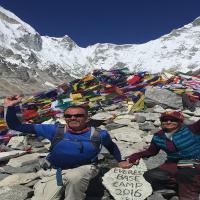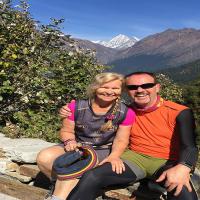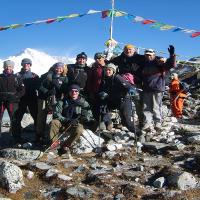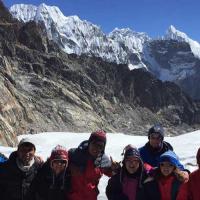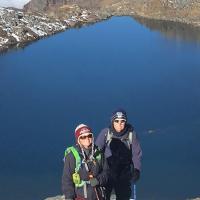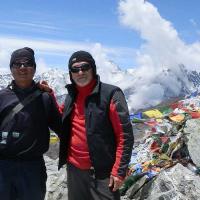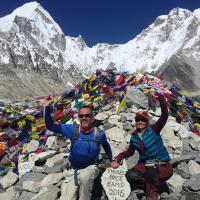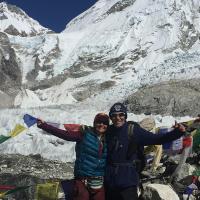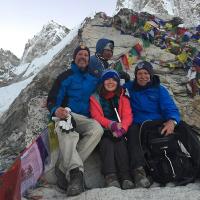

Email Us
contact@destinationhimalayatreks.com
Viber/Whats App 
+977-98510 16814 (Min Gurung)+977-98511 46814 (Tara Rana)
Gokyo Chola Pass Everest Base Camp Trek
$1499 per Pax
Overview
The Gokyo Cho La Pass Everest Base Camp Trek is relatively more advanced than some of the other treks that can be done by a traveler in this area which makes it even more adventurous and fun.
The trek well while also being an amazing sight also encompasses all the ‘usual’ sights in the area, such as Namche Bazar, Tengboche Monastery, Gorak Shep and well The Everest Base Camp but it also has a sighting and visit to the Gokyo Lakes by crossing the high altitude Cho La Pass which sits at around (5,330m).
Since the trek is more ‘adventurous and fun’ compared to the other treks in the area, prepare yourself for long days of 8-9 hours of walking but most of them are of around 5-6 hours in length. This trek is an absolute must for those with high stamina and a sense for adventure.
In this trek flying in and out from Lukla ensures that maximum amount of time is spent in the mountains. However, for the travelers doing this trek acclimatization is a must and this is done in the famous ‘bazar’ of Namche, From Namche Bazar you can visit Syangboche to get a good view of Mount Everest, Lhotse, Ama Dablam, and Thamserku.
While in the bazar you can also visit Khumjung Village where Khumjung Hillary School is located, which was built as a kind gesture by Sir Edmund Hillary as to show his way of giving back to the Sherpa people for all their hard work. This trek takes you through the forests, alpines, prayer flags and waterfall.
After reaching Ngozumpa Glacier the trekkers are then awarded with the view of the three Gokyo lakes and also their favorite drink during this trek, clear water.
One of the Highlights for this trek is the steep climb up to Gokyo Ri (5,357m) which gives an excellent view Mt Everest, Makalu, Cho Oyu, Lhotse. This short trek provides you with magnificent Mountain Views and will act as an acclimatization for the long day ahead to cross The Cho La Pass. You must start the day very early (preferably at around 4-5 AM) in order to cross The Cho La Pass, because of the high strokes of wind that start to set in.
The Trekking Route continues to Gorak Shep, Everest Base Camp, and Kalapatthar, which is also known as Everest View Point. The Gokyo Chola Pass Everest Base camp trek of course has high sets of challenges such as long walks but the rewards make up for it in terms of personal achievement and a unique album of beautiful photos!
If you think that the trek is not for you but you still want to see Gokyo Chola Pass and EBC, consider doing a Heli Tour landing on Everest Kalapathar 5640 meter.
- Explore colorful and culturally rich Namche Bazaar and acclimatize over there
- Trek along Ngozumpa Glacier, the longest glacier in the Nepalese Himalaya
- Engage in the beauty of the sparkling, pristine turquoise waters of the Gokyo Lakes in the Gokyo Valley
- Cross the high altitude pass of Cho La Pass (5,420m)
- Marvelous view of the mountains of Ama Dablam, Cholatse, Lobuche East, and Baruntse from the top of Cho La Pass
- Oldest Buddhist monastery at the Pangboche, the famous Tengboche Monastery
- Picturesque sceneries, and up-close views of Mt. Everest, Mt. Nuptse, Mt. Lhotse, Mt. Pumori, Mt. Ama Dablam, and other snowy mountains from Kalapatthar
- World-famous Khumbu Glacier and Khumbu Icefall en route to EBC
Short Itinerary
Day 01: Arrival in Kathmandu
Day 02: Flight to Lukla and trek to Phakding
Day 03: Phakding to Namche
Day 04: Acclimatization day
Day 05: Namche to Dole
Day 06: Dole to Machhermo
Day 08: Machhermu to Gokyo
Day 09: Gokyo Lake to Thagnak
Day 10: Thagnak to Dzong La via Cho La pass
Day 10: Trek to Lobuche
Day 11: Lobuche to Gorakshep to Kalapatthar
Day 12: Gorakshep to EBC, trek to Pheriche
Day 13: Pheriche to Namche Bazaar
Day 14: Namche Bazaar to Lukla
Day 15: Flight to Kathmandu
Day 16: Transfer to airport for departure
Includes
- All required land transportation as mentioned
- Hotel in Kathmandu with breakfast
- Domestic flight ticket KTM-Lukla-KTM
- Foods and accommodation in trekking
- Well equipped trekking guide and porters
- National park permit and TIMS permit
- Emergency rescue service if in case....
- All local taxes
- Farewell dinner
Excludes
- Personal trekking gears and expenses
- Emergency rescue fee if in case...
- Tip to guide or porters
- Emergency rescue fee if in case
Detail Itinerary
-
Day 01: Arrival in Kathmandu
Upon your arrival at the Tribhuvan International Airport, the representative of Destination Himalaya treks gives you warm welcome in the adventurous Himalayan country Nepal. Transfer to the hotel for an overnight stay.
-
Day 02: Flight to Lukla and trek to Phakding
The views are amazing on this short yet enthralling flight. From the Tenzing-Hillary airport in Lukla, we shall start our trekking expedition to the village of Phakding after getting introduced to the crew members who shall join us from Lukla. Along the mighty and torrential Dudh Koshi river we shall ascend through the forests and wildlife diversity, the prayer wheels and flags, and several suspension bridges along the way before we reach Phakding. Overnight stay.
-
Day 03: Phakding to Namche
We continue our uphill trek along the Dudh Koshi River for the Sherpa hub of Namche Bazaar. The trail starts with an ascent and quickly changes to descend as well as the teahouses start to be fewer in number. In an up-and-down trail, we reach the Monjo village which is almost in the middle of today’s trekking. Little ahead is the gateway to the Sagarmatha National Park where the entry permit is to be taken. The national park office offers valuable information about the flora, fauna, and villages of the region. Descending past the teahouses we reach the settlement of Jorsale from where the trail further leads us through either the less taken path through the pine forest or the other route along the mild climb beside the river. Crossing some suspension bridges we reach the Sherpa hub of Namche Bazaar after the forest checkpoint and past the Everest Viewpoint near Larja Dobhan. Overnight stay.
-
Day 04: Acclimatization day
Today is an acclimatization day. The altitude of Namche Bazaar (3440m) is one of the most popular and ideal places for getting accustomed to the higher altitude ahead. The daytime hiking and exploration of the nearby village of Khumjung can be a good option. This village has the Khunde Hillary Hospital and Hillary School built by Sir Edmund Hillary. A monastery with the skull of Yeti can give a mystic feeling to many visitors to Khumjung. Another highlight is the hike to the Hotel Everest View, the hotel at the highest altitude in the world, for a majestic view of the mightiest Everest. Traditionally a trading hub with locals exchanging yak cheese and butter for agricultural products, Namche hosts tourists and other visitors at present. Overnight stay.
-
Day 05: Namche to Dole
We trek on an easy trail for the first section and then a gradual uphill walk for hours till Phortse Tenga. Continue walking enjoying the Ama Dablam in the backdrop and arrive at Dole. Overnight stay.
-
Day 06: Dole to Machhermo
Head towards Machhermu and get a clear sight of Cho Oyu Mountain on the way to the trail. Pass a few settlements to arrive at Machhermu. Overnight stay.
-
Day 07: Machhermu to Gokyo
You will appreciate the picturesque scenery while trekking to Gokyo. Enjoy the view of Ngozumpa Glacier-the longest glacier in the Nepalese Himalaya, and enchanting lakes in the complex of the Gokyo valley. Overnight stay.
-
Day 08: Gokyo Lake to Thagnak
We shall explore the beautiful Gokyo. We shall view the largest Ngozumpa Glacier and the glacial moraine formed due to the Ngozumpa glacier. Exploring the other locations in the surroundings such as the third, fourth, and fifth Gokyo Lakes. Then, we shall leave the beautiful Gokyo to move ahead in our trek. We have a short yet bit challenging side trip to the other side of the mighty Ngozumpa glacier. Past the first and the second lakes, the trail takes us to the east, the other side of the glacier through the steep pass. We then arrive at our destination Thagnak. Overnight stay.
-
Day 09: Thagnak to Dzong La via Cho La pass
Thagnak is a small and lovely village with few houses. The trek shall start with a gentle long uphill that becomes stiff before the ascent to the challenging Cho La Pass (5,420m). The pass connects the villages of Thagnak and Dzong La. The trail moves past the frozen lake to the Pass decorated with prayer flags. The marvelous view of the mountains of Ama Dablam, Cholatse, Lobuche East, and Baruntse including the others from the top of the pass is an amazing treat to the trekkers. The ice-greased trail may make the descent down to Dzong La a challenging one. The use of crampons for crossing Cho La Pass may be necessary depending on the weather condition. Overnight stay.
-
Day 10: Trek to Lobuche
Today’s section also serves as the preparation for stepping into the vicinity of the Kalapatthar the following day. Through the ridges, on the edge of Awi Peak, we pass through the Cholatse Lake perched above the Cholatse Glacier. We join the busy trail from Tengboche to Lobuche as we turn left towards the Lobuche. As we continue our uphill climb, we have spectacular scenery in front of us wherein the majestic Nuptse seems to be rising above the Khumbu glacier. Overnight stay.
-
Day 11: Lobuche to Gorakshep to Kalapatthar
On the long day of the trek, we shall reach the Gorakshep from Lobuche through the rocky deposits formed due to the Khumbu Glacier. The panoramic view of the majestic mountains includes Pumori, Khumbutse, Nuptse, and Mahalangur mountains among others. We hold our breath at several points during our ascending to the Kalapatthar for observing the jaw-dropping beautiful scenery. We tend to get immersed in the surroundings as we reach the rocky outcrop of Kalapatthar to have several mountains standing proudly in front of us. This summit of Kalapatthar, decorated with prayer flags and cairns, provides one of the most picturesque sceneries ever in any trekking. The picturesque sceneries, and up-close views of Mt. Everest, Mt. Nuptse, Mt. Lhotse, Mt. Pumori, Mt. Ama Dablam, and other snowy mountains from Kalapatthar. We capture the memories as much as we can before trekking back to Gorakshep. Overnight stay.
-
Day 12: Gorakshep to EBC, trek to Pheriche
Today we shall trek across the sandy flat at the Gorakshep and climb onto the moraine of the Khumbu Glacier. Through the fascinating ice glacial, ice columns, and rocky deposits we reach Everest Base Camp. More than the view of Everest itself we can have an extraordinary view of the Khumbu Ice Fall. We shall have the Nuptse above us and the Pumori Mountain behind us as we are immersed in the heavenly environment of the base camp. At Everest base camp, we stay for some time and observe the view of the surrounding mountains. Then we return to Gorakshep for lunch. Then continue to trek to Pheriche. Overnight stay.
-
Day 13: Pheriche to Namche Bazaar
The trek will be easier as the altitude declines. Walk down the steep trail which will be rough too. We will move towards the ending sections of the trekking expedition along the increasingly less-strenuous trail. The cautious trail provides the trekkers with wildlife such as snow leopards, mountain goats, and colorful pheasants as well as the rich dense forest. The conjunction of the Imja River and Dudh Koshi River near Phortse Tenga, the oldest monastery of the region at the Pangboche, the famous Tengboche Monastery at Tengboche are the major highlight of the trekking trail to the unofficial capital of Khumbu region, Namche Bazaar. Overnight stay.
-
Day 14: Namche Bazaar to Lukla
This section marks the last section of the strenuous trekking in the entire expedition. We shall descend the trail slowly and cautiously due to the steep path and the shaky leg owing to the long trekking expedition we earlier had. The magic of nature unfolds through the colorful rhododendron and pine forests, plains, and the amazing view of the snow-capped mountains that seem to be overlooking the trekking route. Sherpa villages, Buddhist culture reflected through the prayer flags, prayer stones, and Gompas, and lush vegetation shall make the trekking an enriching one. We stretch ourselves in this Sherpa town and recall the experiences gained during the strenuous yet amazing expedition. Overnight stay.
-
Day 15: Flight to Kathmandu
Our trekking comes to an end today. We fly back to Kathmandu and you are transferred to the hotel of your stay before you depart to your respective destinations. Overnight in a hotel.
-
Day 16: Final departure
You shall be escorted to the Tribhuvan International Airport (TIA) at least three hours before your scheduled international flight. We hope that this trip has created a fond memory of this amazing Himalayan nation and you have the urge to come again to this beautiful nation.
-
Gokyo EBC CholaPass Trek Info
Accommodation
Accommodation in the Himalayas is mostly teahouses or lodges operated by locals. They are comfortable and simple with basic facilities. Extra facilities like hot showers, Wi-Fi, charging of electronic devices, and laundries are available by paying additional charges. Room sharing is common during the peak seasons and at high altitudes. So, prepared for it. Washrooms are mostly outside the teahouse or lodge.
Meals
We provide only breakfast in Kathmandu and 3 meals (breakfast, lunch. dinner) a day are provided during the entire trek. Meals are provided from the teahouses or lodges which is simple but organic and healthy. Nepali Dal Bhat is a chief dish with fresh green vegetable curry. Besides, noodles, soup, bread, roti, Sherpa stew, and hot drinks are also available. You can try continental cuisine at Namche at your own expense.
Drinking Water
Drinking water in the Himalayas is pure and fresh. One can directly drink the natural freshwater stream from the Himalayas. Or fill up the boiled water in a water bottle in the teahouses paying an extra charge. Always carry water purifying solutions for proper water treatment and to be safe. Drink plenty of water and keep yourself hydrated to prevent altitude sickness.
Internet connectivity & Mobile Network
Everest Link’s Wi-Fi card provides internet all over the Everest region. So, internet connectivity is easily available and stable in the lower regions. Mobile Network is also stable in the lower regions. You can also purchase a Sim and use mobile data from it. In higher altitudes, internet connectivity and mobile network are difficult to find.
Gokyo Lake with EBC Trek Starting Point
Lukla is the starting point for any trekking or climbing in the Everest region. From Lukla, pass through the villages of Phakding, Namche, Dole, and Machhermu to arrive at Gokyo Valley. Explore the Gokyo Lakes and pass through Thagnak, Dzong La, and Lobuche to reach Gorakshep. From Gorakshep, trek to Kalapatthar and EBC the next day.
"Lukla-Phakding-Namche-Dole-Machhermu-Gokyo Valley-Thagnak- Cho La Pass-Dzong La-Lobuche-Gorakshep-Kalapatthar-Gorakshep-EBC-Pheriche-Namche-Lukla"
Required Permits
Permits are mandatory in the Himalayas of Nepal. Our required permits are Khumbu Pasang Lhamu Rural Entrance Permit, and Sagarmatha National Park Permit (SNP).
- Khumbu permit costs NPR 2000 (Foreigners), NPR 1000 (SAARC)
- SNP permit costs NPR 3000 (Foreigners), NPR 1500 (SAARC)
"DH Treks issues all the required permits for it's clients."
Travel Insurance
Travel Insurance is quintessential in the Himalayas. It must cover all emergency evacuation, medical extremities, luggage loss/theft, flight cancellations, altitude above 4000m, etc. Thus, arrange travel insurance from a reputed agency as it is compulsory.
Safety and our guides
We assure you 100% when it comes to safety. Our client’s safety is our main concern. Our guides are certified and well-trained with years of expertise in this field. They are technically competent and have excelled in safety performance. They always carry essential safety equipment, gear, and first-aid kits. For the safety of our trekkers, the itinerary is properly scheduled and acclimatization rest days are properly set up to adjust to the high altitude and prevent altitude sickness. If any queries concerning safety, feel free to share them with our guides. We are always there for your services.
Best time for Gokyo Lake with EBC Trek
The best time to trek is the peak season for safety and to enjoy the spectacular and clear views. Spring and Autumn seasons are the best time followed by the summer season. Winter season is risky and only a few adventurous trekkers dare to climb. We recommend you plan carefully if you want to trek during the off-season.
Gokyo Lake with EBC Trek Difficulty
Gokyo Lake with EBC Trek is moderately difficult due to the long trek route, several ascends and descends, and high elevations, but still, it is adventurous. With the proper assistance and guidance of experts, it is achievable. When it comes to Gokyo Lake with EBC Trek, experience in trekking at high altitudes is a bonus. Besides this, trekkers must be in good health, and physically, & mentally fit as it is physically demanding. So, we recommend you participate in exercises, day hikes, and physical training months before starting the trek. Also, take necessary health tests before trekking to high altitudes. You can completely trust our assistance and guidelines throughout the trekking journey.
Altitude Sickness & Acclimatization
Altitude sickness is common in mountains above the altitude of 3000m. The trek starts from Lukla (2866m) and the altitude rises to Kalapatthar (5,550 m) during the trek. Namche and Machhermu are acclimatization resting places to adjust to the altitude and prevent altitude sickness.
Symptoms of Altitude Sickness
Primary: Headache, nausea, gasping, appetite & sleep loss, dizziness, fatigue, vomiting
Extreme: primary symptoms and hallucinations & unconsciousnessPreventive Guidelines
- Immediately inform the guide
- Warm-up, and body stretch before the trekking journey
- Drink water and Hydrate yourself at regular intervals
- Frequent urination throughout the journey
- Ascend slowly and gradually
- Take plenty of rest and sleep
- Avoid salty foods, alcohol, and smoking
- Descend immediately when it’s difficult/uneasy
- Take medicine consulting a guide
Shoes: Trekking shoes, base camp shoes, Rubber sandals
Clothes: Windcheater jacket, Thermals, Down Jacket, Base Layers, Fleece, Long sleeve shirts, Gloves, Towels, Inner garments, Trekking pants, Trousers, Shorts, Socks
Accessories: Sunglasses, Ski Goggles, Hats/Caps, Beanie, Sunscreen, Lip Balm, Head Lamp, Pocket Knife, Personal Hygiene &Toiletries
Sleeping: Mattress, Warm Sleeping bags
Travel Bag: Duffel bag, a day pack, pack cover
Medicine Kit: Wash Kit, First-Aid Kit, Blister Repair Kit, Medicines for preventing Altitude sickness, Prescribed Medicines (Personal use)
Extras: Heat/Leak proof water bottles, Water Purifying solution (Iodine based), Water filters, Insulated cup/flask, Map, Binoculars, Travel Documents, Sewing kit, Cash, Extra batteries, Power bank, Pen, Diary, Book, Reusable (spoon, cup, plate), Reusable bags, Large Waterproof Disposable Bags, Snacks (Choco-bars, Mints, Nuts, Granola Bars)
Note: Customize and rent the above list as a necessity.

